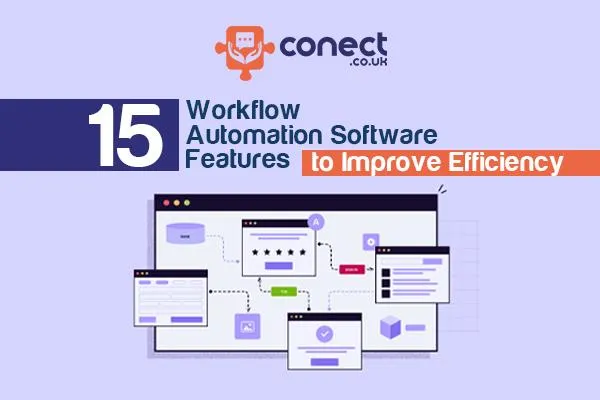
Top 15 Workflow Automation Software Features to Boost Efficiency
15 Workflow Automation Software Features to Improve Efficiency
Businesses are always on the lookout for ways to improve efficiency and streamline operations. One of the best solutions is to implement workflow automation software. These tools help businesses automate repetitive tasks, reduce human errors, and free up valuable time for more critical activities. When properly utilized, workflow automation ensures that your team can work smarter, not harder, while enhancing productivity across the board.
As we explore the top 15 features, you'll discover how the right workflow automation software can drastically transform your organization.
1. Task Scheduling
Task scheduling is one of the most important features of any workflow automation software. This feature allows users to set automated triggers for repetitive or routine tasks, ensuring they occur at the right time without needing constant oversight. For instance, you can schedule daily, weekly, or monthly reports, automate reminders for deadlines, or trigger follow-up emails at specific times.
Let’s say you run a small marketing agency. You might need to send out performance reports to clients every Monday. Instead of manually generating these reports each week, task scheduling enables the software to automatically prepare and send them without any intervention. This keeps your clients updated and your team focused on more pressing tasks.
2. Visual Workflow Builder
A powerful workflow automation tool should provide an intuitive, visual workflow builder. This user-friendly feature allows you to design your workflows with a simple drag-and-drop interface, removing the need for coding skills. Users can easily visualize their processes, mapping out steps and connections between tasks.
Visual builders are invaluable for businesses with large, complex workflows. For example, in a supply chain business, it’s essential to have every step—from order placement to delivery—integrated into a seamless flow. With a visual workflow builder, teams can create customized workflows for each step of the supply chain, making it easier to track and optimize processes.
3. Integration with Other Tools
No workflow exists in isolation. That’s why workflow automation software should integrate seamlessly with other tools in your business. Whether it’s your CRM, email platform, or project management software, these integrations ensure that data flows smoothly between systems without the need for manual entry.
For example, imagine a customer service team using a CRM to track customer interactions. With workflow automation, a customer query can automatically generate a task in the project management system for the appropriate team member. This reduces the risk of tasks being missed or delayed, resulting in better customer satisfaction and quicker response times.
Integrations with popular platforms like Google Workspace, Microsoft Teams, Slack, or Salesforce are common in leading automation tools, ensuring that all your essential systems are interconnected.
4. Conditional Logic
One of the most advanced features of workflow automation is the ability to apply conditional logic. This enables workflows to follow different paths depending on specific conditions or inputs. Essentially, conditional logic allows workflows to adapt to real-world scenarios and handle exceptions efficiently.
For example, in an HR department, onboarding workflows can vary based on an employee’s department or role. Conditional logic ensures that the right paperwork and tasks are triggered for different hires. If the new hire is part of the IT department, the workflow can trigger specific tasks like setting up hardware and software, while a marketing hire may trigger tasks related to creative tools and account setups.
This flexibility enhances workflow customization, allowing businesses to automate even the most complex processes.
5. Automated Notifications
Automated notifications ensure that team members are always in the loop without needing to manually send reminders. These notifications can be triggered by task completions, approaching deadlines, or issues that require immediate attention. Automated notifications keep the workflow moving smoothly and help avoid delays.
For example, let’s assume you’re managing a marketing campaign. When certain milestones are reached—like receiving client approval for creative assets—automated notifications can alert relevant team members to move on to the next step, such as running ads or scheduling social media posts. This reduces downtime and ensures that projects keep progressing as planned.
6. Data Collection and Analysis
Collecting and analyzing data is crucial for businesses, and workflow automation software makes this process easier and more reliable. By automating data collection, you can eliminate errors caused by manual input and receive real-time insights into your workflows. Whether it’s customer information, performance metrics, or task completion rates, automation allows for accurate and efficient data handling.
For example, a sales team using automation can gather data on how leads move through the sales funnel. The system can track which actions are most effective and generate reports on lead conversion rates. Automated data analysis also allows managers to identify areas of improvement quickly, making it easier to optimize workflows over time.
With automated analytics, you can gain valuable insights without spending hours manually compiling data, enabling quicker decision-making.
7. Real-Time Monitoring and Analytics
Real-time monitoring provides a live view of how your workflows are functioning, allowing you to spot inefficiencies, bottlenecks, or delays in real-time. This feature enables teams to address issues as they arise, minimizing disruptions to the workflow.
For example, a logistics company might monitor the delivery process of goods. If there’s a delay in one stage of the delivery, the real-time monitoring system will immediately flag the issue, and the team can intervene to rectify the problem, ensuring the process remains on track.
8. Mobile Accessibility
In today's mobile-driven world, it’s essential that your workflow automation software be accessible from mobile devices. Mobile accessibility allows team members to manage tasks, approve workflows, and stay updated, even while they are on the move.
Consider a construction business where team members are constantly on-site. With mobile accessibility, they can update project statuses, approve materials, or request approvals in real-time from their smartphones or tablets, ensuring smooth communication and timely decision-making.
9. Role-Based Access Control
Sensitive business information requires secure handling. With role-based access control, workflow automation software ensures that only authorized personnel can view or edit certain workflows. This feature provides different access levels based on the user’s role within the company, enhancing security and preventing unauthorized changes.
For instance, in a finance department, only senior management may have access to certain financial workflows. Role-based access ensures that sensitive tasks, such as approving budgets or signing off on large expenses, remain secure and protected from unauthorized users.
10. Approval Processes
Many workflows require approvals at different stages, and automating these approval processes can save significant time. With workflow automation software, tasks are automatically routed to the right individuals for approval, reducing delays and keeping projects moving.
For example, a marketing team might need client approval before launching a campaign. Instead of sending emails back and forth, the workflow can automatically notify the client when a project is ready for review. Once approved, the next steps are triggered, speeding up the entire process.
11. Template Libraries
A well-equipped workflow automation software provides pre-built templates that users can customize. Template libraries make it easier for businesses to implement common workflows quickly, without starting from scratch. These templates can be adapted to fit specific needs, reducing setup time.
For instance, an e-commerce business can use a pre-built template for order fulfillment. The template will include steps for processing payments, updating inventory, and shipping orders. With minimal adjustments, the business can automate a large portion of its order processing workflow.
12. Multi-Step Automation
For more complex workflows, workflow automation software must support multi-step automation. This allows multiple tasks to be triggered sequentially, ensuring that every aspect of the process is automated and executed in the correct order.
For example, when onboarding a new employee, multi-step automation can ensure that once the contract is signed, tasks such as setting up payroll, email accounts, and software permissions are triggered automatically. This ensures that nothing is overlooked, and new hires can start their roles fully equipped on day one.
13. Collaboration Tools
Built-in collaboration tools within workflow automation software help teams communicate more effectively. Features like shared task lists, real-time updates, and commenting options make it easy for team members to collaborate, share updates, and track progress in one centralized system.
For example, in a creative agency, designers, copywriters, and project managers can collaborate on a single workflow, making updates and providing feedback without the need for lengthy email threads. This fosters a more streamlined and efficient work environment.
14. Audit Trails and Compliance
Audit trails provide a transparent view of all changes made within a workflow. This feature is critical for compliance purposes, as it shows who made changes, when they were made, and what changes occurred. Audit trails are particularly useful in industries where regulatory compliance is important, such as finance or healthcare.
If there’s ever a question about why a particular task was completed or who approved a document, the audit trail provides a clear record, enhancing accountability.
15. Scalability and Customization
As businesses grow, so do their workflow needs. A good workflow automation software should be scalable, meaning it can grow with your business without losing efficiency. The software should also allow for customization, so you can modify workflows to suit your unique business requirements as they evolve.
For example, a small startup may only need basic automation at first, such as task scheduling and email notifications. But as the business expands, it may require more complex workflows that handle multi-step processes, integration with other tools, and data analysis. Scalability ensures the software can accommodate this growth without slowing down or becoming outdated.
Conclusion
Workflow automation software is an invaluable tool for businesses seeking to streamline operations, reduce manual tasks, and improve overall efficiency. By incorporating these 15 features into your automation toolkit, you can ensure that your processes run smoothly, your team remains productive, and your business can adapt to future growth.
Automation is the key to unlocking higher efficiency and freeing your team to focus on strategic, high-value tasks. Start exploring workflow automation software today and see how it can revolutionize the way you work.

The All-In-One Solution to grow your business. Capture Free Leads And Conversationally Covert Them Into Customers!
Contact information
Address : Layton Lane, Rawdon, Leeds, LS19 6RG
Phone : +44 7859 775480
Email : [email protected]

